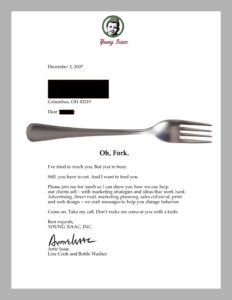
One day, long ago, Brooks Young came to me with a frustration.
Brooks was the original “Young” of Young Isaac. (“Young” was never my modifier. If so, we would have long ago become “Aging Isaac.”)
He was frustrated that some big potential clients would not return his calls. Brooks was our Bird Dog In Chief, charged with new business. And, dag-nab-it, some people just wouldn’t return his calls.
Perhaps they had never heard of us. Perhaps they didn’t know that we could help. Perhaps they didn’t know they needed help. Whatever. Messages left. Few return calls.
Brooks asked me what he might do.
I Was A Bitter Young Man
So I said, “Send them a fork in the mail and tell them to fork off.”
Brooks laughed and walked away.
But he soon returned.
“There’s an idea in that,” he said. “Think some more about it.”
That’s part of Brooks’ brilliance. He can hear anything and see the value. It’s a talent that all of us would be wise to develop.
The Fork Letter Was Born
After a week or so, the idea was built and launched.
It’s a business letter on letterhead. Attached to a board. Holes are drilled in the board and a fork is rubber-banded to the board. An inexpensive $1 fork. No big deal.
The perky text reads:
Dear [potential client]:
I’ve tried to reach you. But you’re busy.
Still, you have to eat. And I want to feed you.
Please join me for lunch so I can show you how we can help our clients sell – with marketing strategies and ideas that work hard. Advertising, direct mail, marketing planning, sales collateral, print and web design – we craft messages to help you change behavior.
Come on. Take my call. Don’t make me come at you with a knife.
[signed, etc.]
That “come after you with a knife” was inappropriate for many months following 9/11. In time, however, we were again able to use the letter.
It Works
The “Fork Letter” was mailed to several folks that hadn’t returned Brooks’ repeated calls. He’d left messages, but no calls.
They called back. Right away.
It was so effective that Brooks wanted to just mail the letters out. “Why bother calling and leaving messages that they won’t return?” he asked.
We did it a couple times. The recipients would call back, somewhat exasperated, saying, “But I never received any messages from you.”
So Brooks still made the often futile calls. Otherwise, we’d be cheating.
We’d Always See The Letter Again
So, we would go visit the prospective client. (A fork had died, that we might live.)
And we would usually see the original fork letter sitting in a windowsill or against a wall.
We’d see it and say, “Hey, that’s our fork letter.”
The prospective client would say: “Oh, yes. That’s right. That’s how you got this meeting — say, can you do that for me?”
“Make you look like a lunatic? Sure. But what’s right for our business might be wrong for yours. Let’s find the tool that works best for you.”
Why Is The Fork Letter Always Sitting Out?
Because:
- It can’t be filed. The fork is too bulky and potentially dangerous in a file cabinet.
- It can’t be thrown away. Forks are too precious. We all chase forks down garbage disposals, risking life and limb. Forks are dear to us. (Why? Because the fork is to the adult what mother’s breast is to the infant.)
Don’t get mad. Get even. Fork ’em.
The fork letter is featured in I’ll Get Back to You: 156 Ways to Get People to Return Your Phone Calls, edited by my friend Robert L. Shook.
